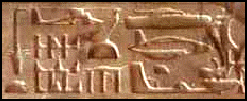I have thoroughly debunked that palimpsest in other places. Once this thread is moved to its appropriate forum (Pseudodscience), perhaps I'll repost that debunking.
Edit: what the hell... I'll re-post it here:
There's a very good explanation that we archaeologists understand very well: a palimpsest combined with pareidolia. This palimpsest pops up from time to time. What we see here isn't a
single inscription but two or three. As different pharaohs took over, they frequently had inscriptions updated with a very simple method that 'erased' the previous inscription: they had their scribes fill in the old script with plaster and inscribe a new one.
The original, un-retouched palimpsest is here:
Here's an overlay of the two, and possibly three, different text layers. Each layer is translatable and has context.
This is the text in it's context with the pharaoh's cartouche to the left.
What the original text says is, "who repulses the Nine Bows" and the text that replaces it says, "who protects Egypt and overthrows the foreign countries." These are called titularies, or
naming conventions of important people, in this case pharaohs. Specifically, the pharoahs in question are Seti I (for whom the first titulary of the palimpsest was dedicated to) and then his son and successor Ramesses II (for whom the second titulary of the palimpsest is dedicated).
The plaster of the palimpsest was eroded, probably by water leaking in through the ceiling. Notice, in the OP's first image the damaged ceiling and the direction of the damage is consistent with the eroded area of the palimpsest.
There are no "flying machines" in Egyptian antiquity. Sorry to disappoint the significance-junkies out there. But the mystery-mongers need not fret because the intricacies of the hows and whys of dynastic politics in Egypt's antiquity are many and little understood.



